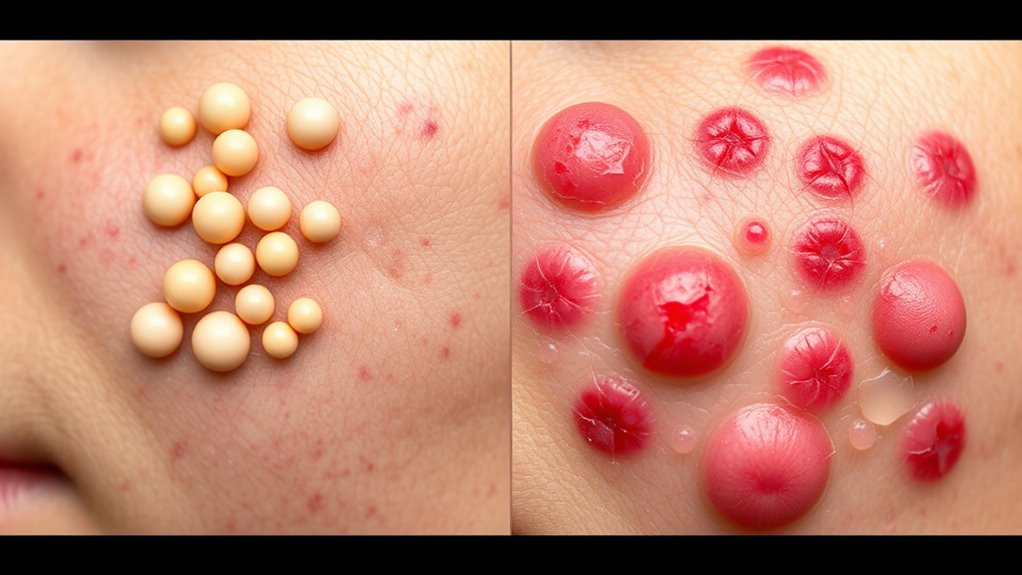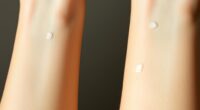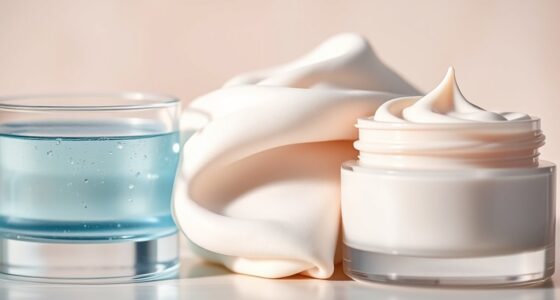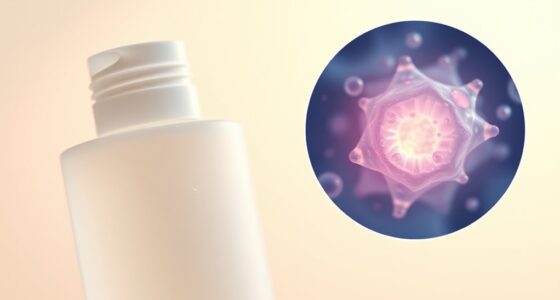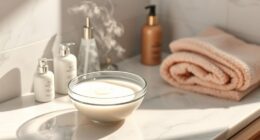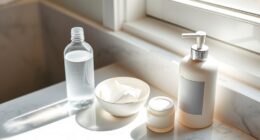Fungal acne usually shows up as uniform, itchy pustules on your chest, back, or shoulders, and tends to be less inflamed. Bacterial breakouts, however, are more varied, with inflamed, often pus-filled pimples mainly on your face, especially the jawline and cheeks. To tell them apart quickly, consider the size, location, and how they feel—fungal bumps are less painful. Keep exploring to uncover more tips for identifying and treating each type effectively.
Key Takeaways
- Fungal acne appears as uniform, itchy pustules mainly on the chest, back, or shoulders, while bacterial acne shows varied, inflamed pimples mostly on the face.
- Fungal bumps are less inflamed and painful, whereas bacterial pimples tend to be tender, pus-filled, and more inflamed.
- Location helps distinguish: fungal acne favors body areas; bacterial acne is common on the jawline and cheeks.
- Fungal acne responds to antifungal treatments; bacterial acne improves with antibacterial cleansers and spot treatments.
- Proper diagnosis based on appearance and location ensures effective, targeted skincare.
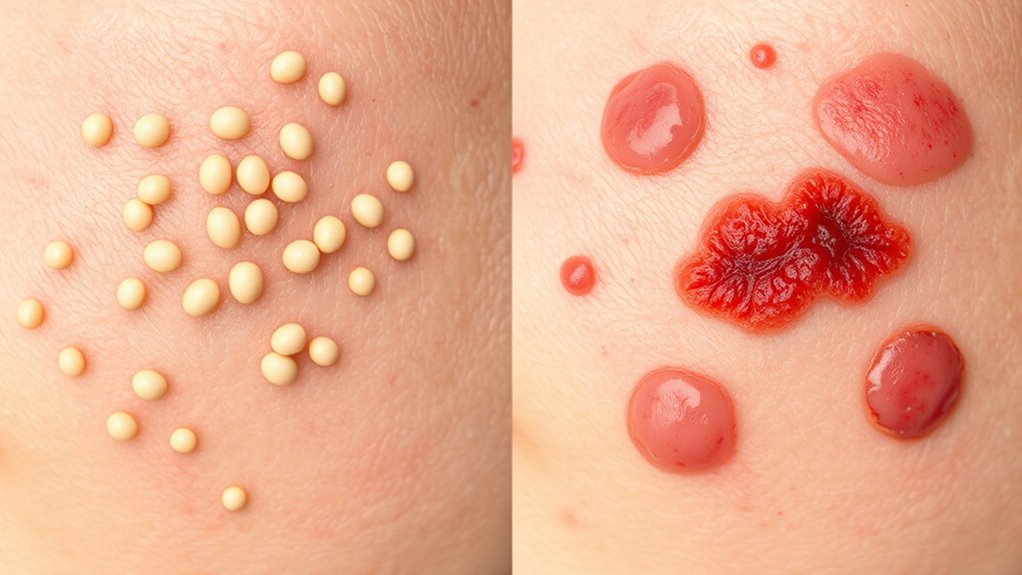
Understanding the difference between fungal acne and bacterial breakouts is essential for choosing the right treatment and preventing further skin issues. While they might look similar at first glance, the underlying causes and how they manifest on your skin are quite different. Fungal acne, also known as Malassezia folliculitis, occurs when a yeast called Malassezia overgrows in your hair follicles. This overgrowth often results from factors like excess moisture, oily skin, or disruptions in your skin’s natural environment. One key aspect to consider is keratin buildup, which can trap the yeast within your pores, making it harder for your skin to clear the infection. Additionally, your skin’s pH balance plays a vital role — if your skin becomes too acidic or alkaline, it can disrupt the natural flora, encouraging yeast proliferation. Maintaining a balanced skin pH helps inhibit fungal growth, making it less likely for fungal acne to develop or worsen. Proper hygiene practices and avoiding occlusive skincare can also help prevent fungal overgrowth.
In contrast, bacterial breakouts are usually caused by overgrowth of bacteria like Propionibacterium acnes. These bacteria thrive in environments rich in excess oil and dead skin cells, which clog pores and create an ideal breeding ground for bacteria. Bacterial acne often presents as inflamed pimples, cysts, or pustules that may be painful or tender. Unlike fungal acne, bacterial breakouts tend to respond well to antibacterial treatments, such as benzoyl peroxide or topical antibiotics. They can also be exacerbated by hormonal fluctuations, stress, and certain skincare products that strip your skin’s natural barrier, leading to increased oil production and bacterial growth. Recognizing the underlying cause helps determine the most effective treatment approach and avoid unnecessary irritation.
Spotting the difference quickly involves paying attention to the appearance and location of your breakouts. Fungal acne typically manifests as uniform, itchy pustules or papules, often on the chest, back, or shoulders. These bumps are usually similar in size and may not be as inflamed or painful as bacterial acne. Bacterial breakouts often appear as varied-sized pimples, with some being inflamed or pus-filled, and are more common on the face, especially around the jawline and cheeks. Considering skin microbiome balance can further aid in understanding and managing these skin conditions effectively.
Understanding these distinctions helps you choose the right treatment. If you suspect fungal acne, antifungal creams and maintaining a balanced skin pH are crucial. For bacterial breakouts, antibacterial cleansers and spot treatments are more effective. Recognizing whether your skin issue stems from fungal or bacterial causes allows you to tailor your skincare routine appropriately, preventing unnecessary irritation and promoting healthier skin.
Frequently Asked Questions
Can Fungal Acne Develop on the Body or Just the Face?
You might wonder if fungal acne can develop on your body or just your face. The answer is, it can appear on various skin regions, not limited to your face. Fungal acne causes body eruptions that typically show up on shoulders, chest, back, and arms. It’s caused by yeast overgrowth, so keep an eye on any persistent itchy bumps in these areas. Proper treatment helps clear up these fungal infections effectively.
Are There Specific Skincare Ingredients to Avoid With Fungal Acne?
You should avoid skincare ingredients that can trigger ingredient sensitivities or worsen fungal acne. Steer clear of ingredients like oils high in oleic acid, esters, and fatty acids that promote fungal growth. Be cautious with ingredient interactions, such as using occlusive or greasy products that trap moisture. Always read labels carefully, and patch test new products to prevent reactions. Sticking to antifungal-friendly ingredients helps manage fungal acne effectively.
How Long Does It Typically Take to See Improvement?
You might notice that improvement varies, but often, you’ll see some symptom relief within 2 to 4 weeks of consistent treatment. The key is patience, as treatment duration depends on the severity and type of breakout. Keep track of your progress, and if there’s no change after a month, consider consulting a dermatologist. Usually, with proper care, you’ll observe clearer skin and reduced irritation in this timeframe.
Is Fungal Acne Contagious or Spread Through Skin Contact?
Fungal acne isn’t highly contagious, but there’s a small contagion risk through skin contact, especially if you have weakened immunity or share personal items. It mainly spreads in humid environments or communal spaces. To reduce risk, avoid sharing towels or clothing, and keep affected areas clean and dry. While skin contact might transfer fungi, it’s less contagious than bacterial infections, so maintaining good hygiene helps prevent spreading.
Can I Use Antibiotics for Fungal Acne Treatment?
You might wonder if antibiotics are effective against fungal acne, but they typically target bacteria, not fungi. Using antibiotics for fungal acne isn’t recommended, as it won’t address the fungal resistance causing your breakouts. Instead, you should consider antifungal treatments prescribed by your dermatologist. Relying on antibiotics could worsen your condition or lead to resistance, so always get a proper diagnosis before starting any medication.
Conclusion
Think of fungal acne and bacterial breakouts as two rival kingdoms vying for your skin’s attention. Knowing the difference is like having a map in a dense forest—guiding you to the right path. With quick identification, you can avoid the trap of missteps, just like a seasoned traveler sidestepping pitfalls. Stay vigilant, and you’ll navigate your skin’s landscape with confidence, ensuring your radiant glow remains victorious in the battle of clarity.
